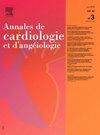Faisabilité et sécurité de l’abord radial droit pour l’angiographie des pontages mammaires internes gauches
IF 0.3
Q4 Medicine
引用次数: 0
Abstract
Background
The right radial approach has become the preferred access route for coronary angiography and percutaneous coronary intervention. However, its use for left internal mammary artery graft (LIMA) angiography in patients with prior coronary artery bypass grafting (CABG) remains controversial. This study aimed to assess the feasibility and safety of the right radial approach compared with the left radial and femoral approaches for LIMA graft angiography.
Methods
We compared feasibility criteria (LIMA visualization and selective engagement, procedure duration, contrast volume, and fluoroscopy time) and safety parameters during LIMA graft angiography, across right radial, left radial, and femoral access in 760 post-CABG patients.
Results
LIMA visualization was successful in 92% of cases via the right radial access, compared to 96% for both the left radial and femoral access (p = 0.158). Selective LIMA engagement was significantly lower with the right radial access (61%) than with the left radial (86%) and femoral (78%) access (p < 0.0001). No significant differences were observed in procedure duration, fluoroscopy time, or contrast volume. Haemorrhagic complications were significantly less frequent with the right radial approach (0%) compared to the femoral approach (6%, p = 0.0001). The rates of radial artery spasm and occlusion were similar between the two radial access groups.
Conclusion
The right radial access is a safe and effective alternative for LIMA graft angiography in post-CABG patients. It represents a valuable option when the left radial artery is unavailable, allowing to avoid the femoral access and its associated complications.
左内乳房搭桥手术右放射线血管造影的可行性和安全性
背景右桡动脉入路已成为冠状动脉造影和经皮冠状动脉介入治疗的首选入路。然而,它在冠状动脉旁路移植术(CABG)患者左内乳动脉移植(LIMA)血管造影中的应用仍存在争议。本研究旨在评估右桡骨入路与左桡骨和股动脉入路在LIMA血管造影中的可行性和安全性。方法我们比较了760例cabg后患者在右桡骨、左桡骨和股动脉通道进行LIMA血管造影的可行性标准(LIMA可视化和选择性介入、手术时间、造影剂体积和透视时间)和安全性参数。结果通过右侧桡骨通路的lima显像成功率为92%,而左侧桡骨和股骨通路的lima显像成功率为96% (p = 0.158)。右桡骨入路的选择性LIMA接合度(61%)明显低于左桡骨入路(86%)和股骨入路(78%)(p < 0.0001)。在手术时间、透视时间或造影剂体积方面没有观察到显著差异。与股骨入路(6%,p = 0.0001)相比,右侧桡骨入路出血并发症发生率明显较低(0%)。桡动脉痉挛和闭塞的发生率在两个桡动脉通路组之间相似。结论右桡骨入路是冠状动脉搭桥术后LIMA血管造影安全有效的选择。当左桡动脉不可用时,它是一个有价值的选择,可以避免股骨通路及其相关并发症。
本文章由计算机程序翻译,如有差异,请以英文原文为准。
求助全文
约1分钟内获得全文
求助全文
来源期刊
CiteScore
0.60
自引率
0.00%
发文量
68
审稿时长
6-12 weeks
期刊介绍:
Organe scientifique de référence fondé en 1951, les Annales de cardiologie et d''angéiologie abordent tous les domaines qui intéressent quotidiennement les cardiologues et les angéiologues praticiens : neurologie et radiologie vasculaires, hémostase, diabétologie, médecine interne, épidémiologie et prévention.
Les Annales de cardiologie et d''angéiologie sont indexées aux grandes bases de données et publient rapidement, et en conformité avec les normes internationales de publication scientifique, des articles en français sur la pathologie cardiaque.

 求助内容:
求助内容: 应助结果提醒方式:
应助结果提醒方式:


